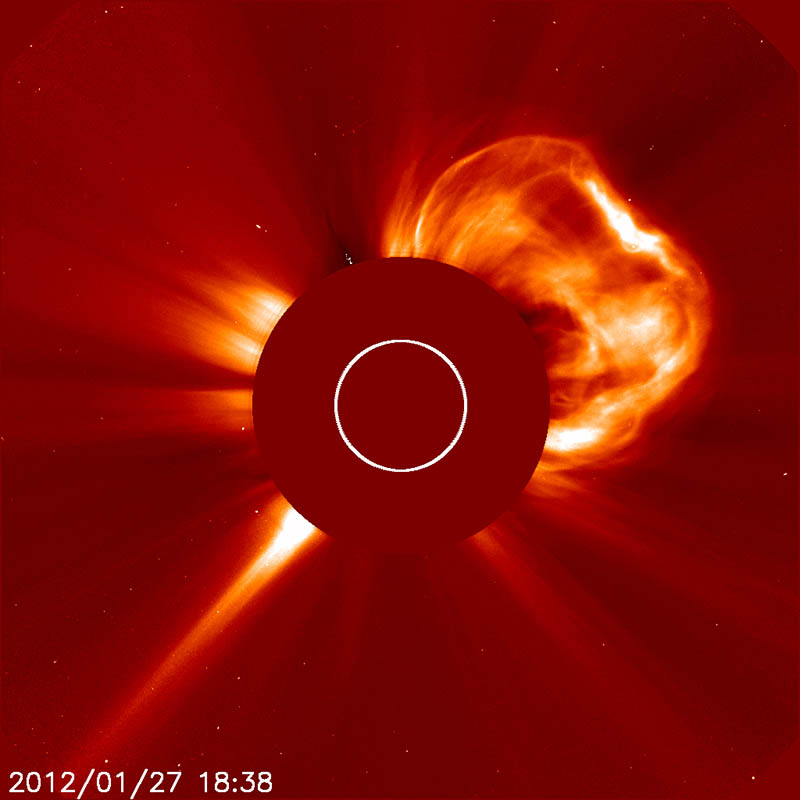Title image is atomic oxygen lighting up the tail of Space Shuttle Columbia; NASA Image STS-62-42-026.
Although space notionally begins at around 80 – 100km up, it doesn’t just suddenly become an empty vacuum. Instead, the space environment is complex and hostile. As altitude increases and atmospheric density decreases, the atmosphere becomes increasingly rarefied, meaning the distance between individual molecules becomes bigger.
This means that an individual molecule will travel further and further as altitude increases before it collides with another molecule.
The Earth’s atmosphere has an effect on all spacecraft up to at least 500km, but on occasions to over 1000km. The most noticeable effect is drag, which scrubs off orbit energy and causes the spacecraft to lose altitude.
Spacecraft orbital velocities result in high-energy impacts with atmospheric molecules, causing things like oxygen erosion, which can be a serious problem, and over years can cause some materials to completely disintegrate. Interaction of oxygen atoms with spacecraft surfaces can also create an orange glow on surfaces facing into the atmosphere, as seen in the title image.
Physical impacts on a spacecraft come from two main sources, meteoroids, and debris from other space activities. In low-Earth orbit, the greater risk is from debris. Meteoroids are solid particles orbiting in interplanetary space, often fragments of comets or asteroids. Saturn’s rings are a special case of these particles. When a meteoroid hits the atmosphere, it becomes a meteor, or a shooting star.
Physical impacts on a spacecraft, even from tiny particles, can be devastating. Meteoroid impact velocities average between 20 and 30km/s, but can be as high as 500km/s. Meanwhile, space debris impacts are typically around 10km/s. For context, a high velocity bullet will travel at around 1km/s. Physical impacts cause effects ranging from pitting, to creating holes, or even total destruction.
Electric and magnetic fields exist around most bodies in space, including the Earth and the Sun. Mars, the Moon and Venus don’t have significant magnetic fields, and Mercury’s is very weak.
Space also contains a number of plasma environments. Plasma being one of the four fundamental states of matter, alongside gas, liquid, and solid. Plasma is likely the most abundant form of ordinary matter in the universe, yet it’s probably the one you know least about.
Like a gas, a plasma does not have a shape or limited volume. Unlike a gas, plasma can conduct as well as produce electricity, and can produce and respond to magnetic fields.
The solar wind is a neutral plasma flowing approximately outwards from the Sun, interacting with the Sun’s magnetic field. When the solar wind impacts Earth’s atmosphere it causes it to heat-up and expand, meaning the atmosphere’s density varies over time.
The ionosphere is a region of Earth’s upper atmosphere, from about 60 to 1000km, that is ionized by solar radiation, and is typically a comparatively dense, ‘cold’ plasma.
Above the ionosphere is a ‘hot’ plasma of lower density, but higher energy. These particles, primarily electrons and protons, reach down to the Earth’s atmosphere at high latitudes causing the auroras, or northern and southern lights. Auroras are also regularly observed at other planets, including Jupiter and Saturn.
Ultraviolet and extreme ultraviolet radiation is absorbed by the Earth’s atmosphere but in space can change the surface chemistry of materials, and cause photoelectron emission. Meanwhile infrared radiation, which mostly comes from the Sun, is a major source of thermal effects on spacecraft. These thermal effects, that is, keeping the spacecraft components at the correct temperature, are one of the most important environmental concerns for spacecraft.
Trapped within the Earth’s magnetic field are high energy electrons and protons, the so-called radiation or van Allen belts. Other forms of radiation include galactic cosmic rays, that is, high-energy particles originating outside the solar system, and solar particle events, which are mostly protons, emitted by the Sun into interplanetary space by a coronal mass ejection. That is, an expulsion of plasma from the Sun released into the solar wind. Solar particle events are generally a few to several orders of magnitude more intense than galactic cosmic rays but with lower energy and typically last no more than a few days. Trapped radiation and solar particle events are the two major natural radiation sources of concern to spacecraft engineers.

Radiation causes material characteristics and electronic parts to slowly degrade with time, but can also cause sudden glitches, such as single event upsets, produced in an integrated circuit when a single charged particle passes through causing a change of state, that is, it flips a ‘0’ to a ‘1’, leading to data loss or incorrect commands. This type of error can be detected through error correction algorithms in on-board software. Similar algorithms are actually used in electronics on Earth to counter the effects of things like cosmic rays that penetrate the atmosphere.
Another serious concern can be buried charging, where particles penetrate the spacecraft and charge internal structures, causing arcing inside the spacecraft. At Earth, at least 2.5mm of aluminium shielding is needed to prevent this, and this is typically enough shielding to reduce the effects of other types of radiation damage.
So, yes. The space environment is complex and hostile, and building a successful spacecraft can be hard.
Electronic & Electrical Engineering
Royal College Building
204 George St.
Glasgow G1 1XW